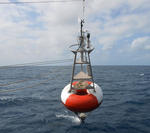Cold tongue and African Monsoon
Provided by Christophe MAESAdding a pinch of salt or putting a little less cold water, the oceanic cooking recipe going on in the Gulf of Guinea may play a major role on the African monsoon rainfall patterns. In order to unravel the spicy recipe and shed some light on the processes driving the hydrological cycle – which is a key element for the West African societies, scientists endeavoured to understand the “Atlantic cold tongue process” [1]. “This equatorial zone of the ocean goes through, each year during the north hemisphere spring/summer period a double phenomenon which is closely related to the rainfall in western Africa as already known. Casimir Da-Allada, an oceanographer, explains that surface water cools down while its salinity increases to reach a maximum in June for salinity but only in July for the low temperatures.
 (c) IRD / B. Bourlès Bouée Pirata lors d’une campagne océanographique dans le golfe de Guinée
(c) IRD / B. Bourlès Bouée Pirata lors d’une campagne océanographique dans le golfe de Guinée
The challenge is to link these two parameters whose maxima are separated by a month. Eventually, researchers hope to anticipate the temperature from the salinity measurements obtained a month before to derive rainfall forecasts over West Africa. From such information, it would be possible to anticipate rainfall volume and decide as early as June, whether to sow high yield but water demanding seeds or, conversely, more rustic, lower yield, seeds able to survive droughts…
 (c) CESBIO A Albitar: Root zone soil moisture to estimate a drought index from SMOS
(c) CESBIO A Albitar: Root zone soil moisture to estimate a drought index from SMOS
So as to study this possibility, scientists made use of the ESA led SMOS mission [2] as well as in situ PIRATA buoys measurements [3]. They have developed numerical simulation models and derived the salt budget of the cold tongue and identified the vertical transport processes in the water column. “According to our results, the salinity change occurring at the end of spring is linked to the seasonal equatorial sub current activity, which pushes upwards the deep water towards the surface” indicates the scientist. “Less subject to incoming fresh water (rainfall and river outflow), the sea water is saltier than surface water”. Ongoing studies evaluate the relevance of salinity as an indicator of intensity of the cool tongue seasonal onset. Once done, it will be necessary to confirm its ability to help better anticipate the African Monsoon.[1] Da-Allada, C. Y., Jouanno, J., Gaillard, F., Kolodziejczyk, N., Maes, C., Reul, N. and Bourlès, B. (2017), Importance of the Equatorial Undercurrent on the Sea Surface Salinity in the Eastern Equatorial Atlantic in boreal spring. J. Geophys. Res. Oceans, 122
[2] Kerr, Y.H., Waldteufel, P., Wigneron, J.P., Delwart, S., Cabot, F., Boutin, J., Escorihuela, M.J., Font, J., Reul, N., Gruhier, C., Juglea, S.E., Drinkwater, M.R., Hahne, A., Martin-Neira, M., & Mecklenburg, S. (2010). The SMOS Mission: New Tool for Monitoring Key Elements of the Global Water Cycle. Proceedings of the Ieee, 98, 666-687
[3] Prediction and Research Moored Array in the Tropical Atlantic
